
Tiles Design for Floor Ideas: Living Room, Bedroom, Kitchen, Bath
08 Oct, 2025
Tiles design for floor starts with a few quick questions. Which choice makes a small living room feel larger when morning light spills in? Which pattern keeps its grip in monsoon yet stays elegant at Eid? Which color hides weekday dust but still brightens a shaded hallway?
This guide walks room by room with ideas you can install. You might think large matte marble looks for living rooms, warm wood styles for bedrooms, and easy clean textures for kitchens and baths. Today you will see sizes that stretch space, layouts that lead the eye, and finishes that stay safe under wet feet.
Ready to choose a floor you will love every day?
Why Floor Tiles Design Matters for Different Rooms?
Floors do quiet work. They carry traffic, light, spills, and mood, and each room asks for a slightly different answer. Here are some compelling reasons why you should care about floor tiles design-
- Room size and tile scale: Large-format tiles can make a small room feel more open by reducing joint lines, while smaller tiles work better in tight, irregular spaces like bathrooms.
- Light flow and surface finish: Glossy tiles reflect more light but may glare in bright rooms. Matte or satin finishes diffuse light and offer a calmer, softer look, especially useful in bedrooms and north-facing spaces.
- Slip resistance: Textured or matte tiles offer better grip in wet areas like bathrooms, kitchens, balconies, or entryways. Check DCOF (Dynamic Coefficient of Friction) or anti-slip ratings where possible.
- Maintenance and grout color: Lighter tiles show stains more easily in high-traffic zones unless paired with matching grout. Darker grout hides dirt but can visually divide a space if overused.
- Temperature and comfort underfoot: Some finishes feel cooler or warmer underfoot, especially in bedrooms where you often walk barefoot. Wood-look or structured stone-look tiles tend to feel cozier.
- Visual flow between rooms: Using consistent tile designs or coordinating tones across open-plan spaces helps the eye travel more naturally and makes the home feel larger and more unified.
Floor Tiles Design Ideas for Every Room
You may think one gorgeous floor tile design can be replicated for different rooms. But in reality, different rooms demand different arrangements to get their distinctive appeal. So, floor tiles design ideas should be different accordingly. Here is a quick suggestions for all rooms you can follow-
1. Living room
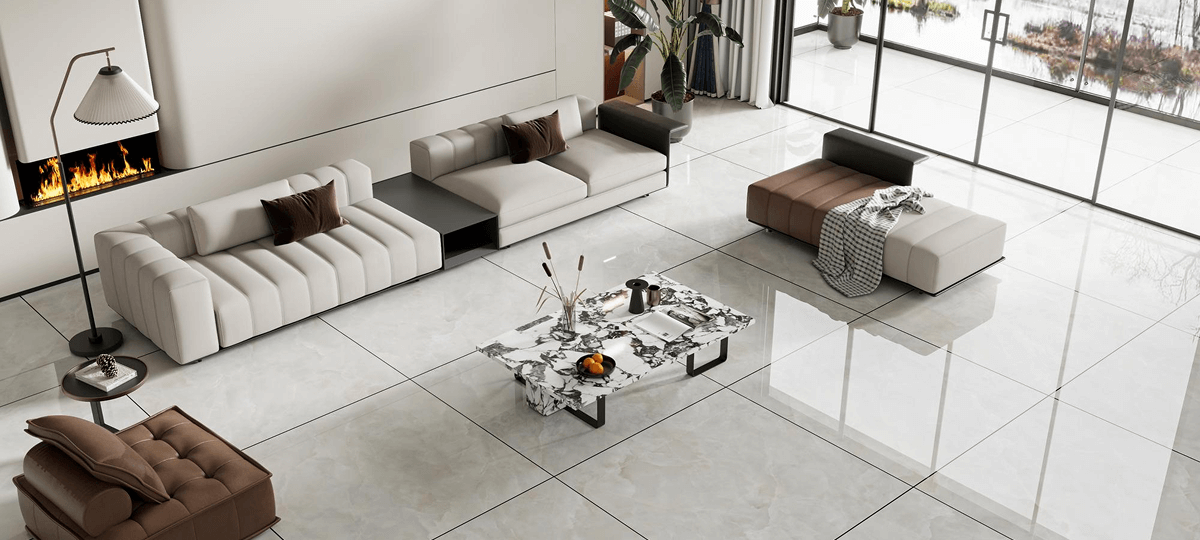
The living room sets the tone for your entire home, so your tiles design for floor should balance comfort with visual flow. Large-format tiles offer fewer grout lines, making your living room look bigger. So, using large tiles could be a great idea when your living room is small. Large-format tiles come in stone, marble, or terrazzo materials at justified price ranges. You can choose warm neutral tones if you want cozy depth, or light beige and off-white to amplify natural light. For pattern, a staggered or diagonal layout guides the eye smoothly across the space. If you entertain often, go for a matte or low-sheen finish to hide footprints while keeping the surface elegant. The right design quietly frames everything that happens above it.
2. Bedroom
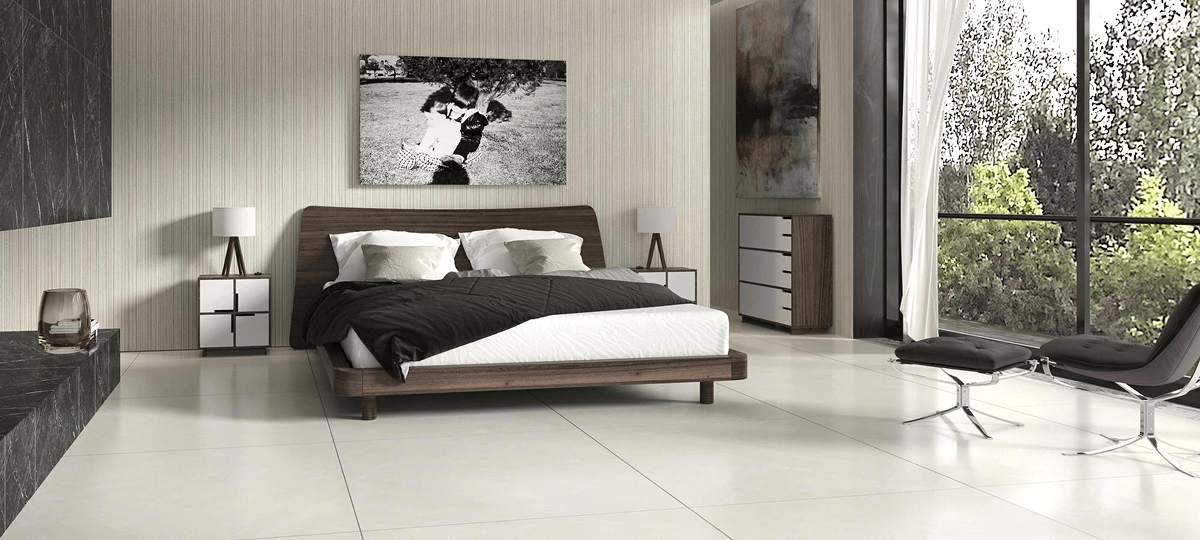
Bedrooms call for calm underfoot. When choosing tiles design for your bedroom floor, start with how the light moves through your space. Matte or satin finishes soften reflections and create a restful mood. On the other hand, wooden tiles bring warmth without the upkeep of timber, while soft stone or terrazzo designs add texture that feels timeless. So, choosing medium or large tile will be a great idea as they reduce grout lines and make the room appear more open. Keep grout colors close to the tile shade for a seamless, easy-to-clean surface. The goal is quiet comfort. So use tiles that stay cool, glare low, and retain an inviting vibe through every season.
3. Kitchen
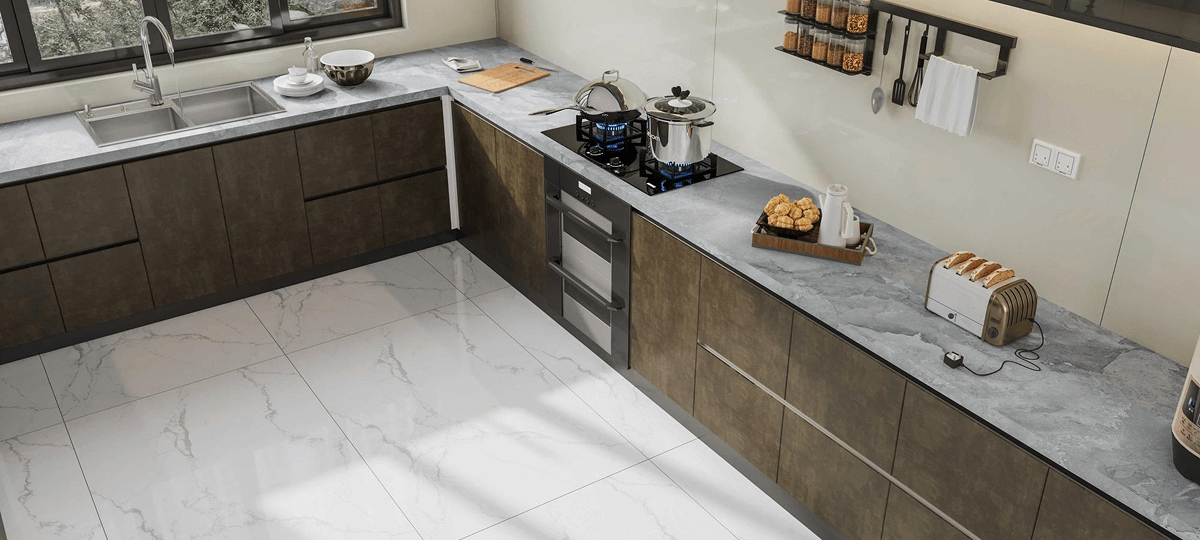
The kitchen floor works harder than any other room of your house. It faces heat, spills, grease, and constant foot traffic, so you need to ensure the right tiles design for floor that balances beauty with durability. Mid-tone porcelain or vitrified tiles are ideal for kitchen floors because they hide stains and resist moisture. You can also go for matte or lightly textured finishes to reduce slipping when the floor is wet, especially when your kitchen design complements this arrangement. Patterns like checkerboard or small hexagons can zone the cooking area without feeling busy. And neutral shades such as beige, grey, or light stone complement most cabinets and reflect light well. And don’t forget to seal grout lines and choose narrow joints for easier cleaning.
4. Bathroom
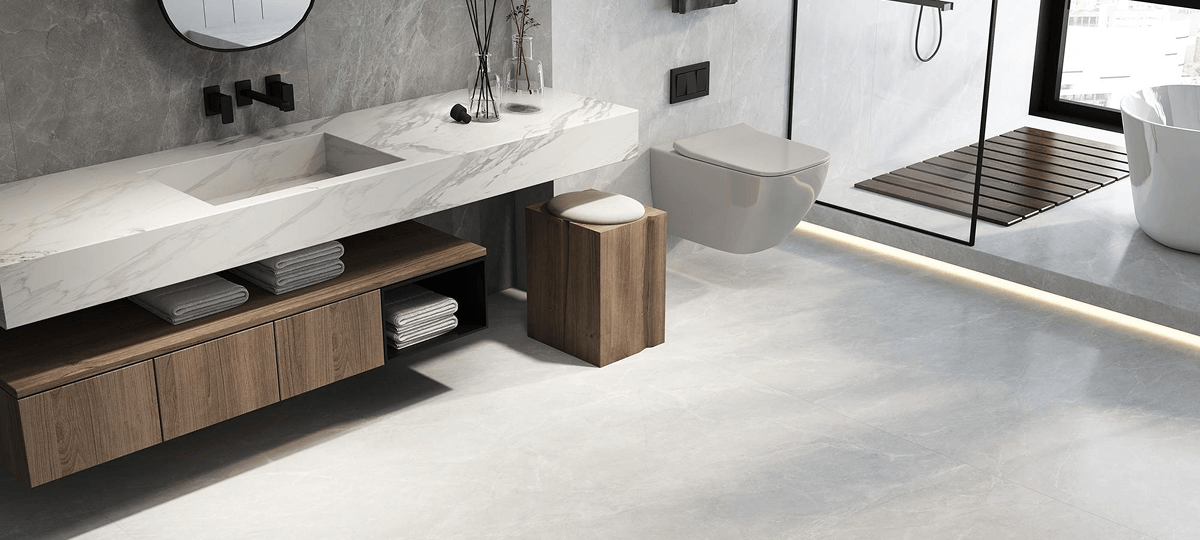
Your bathroom works hard as it deals mostly with constant water splashes and dirt. So the floor must give grip, drain well, and stay easy to clean. You can choose matte or structured porcelain with a high wet DCOF value; it helps under soapy feet. Smaller format tiles near the shower helps the installer create a gentle 1 to 2 percent slope to the drain. Try to keep grout narrow and pick epoxy for mold control. Light colors lift small rooms; mid tone neutrals hide water spots. So pick one option considering your preference. If you love patterns, try hex or checkerboard in a low sheen finish. And it’s best to test a sample under your bathroom lighting before you buy.
5. Dining room
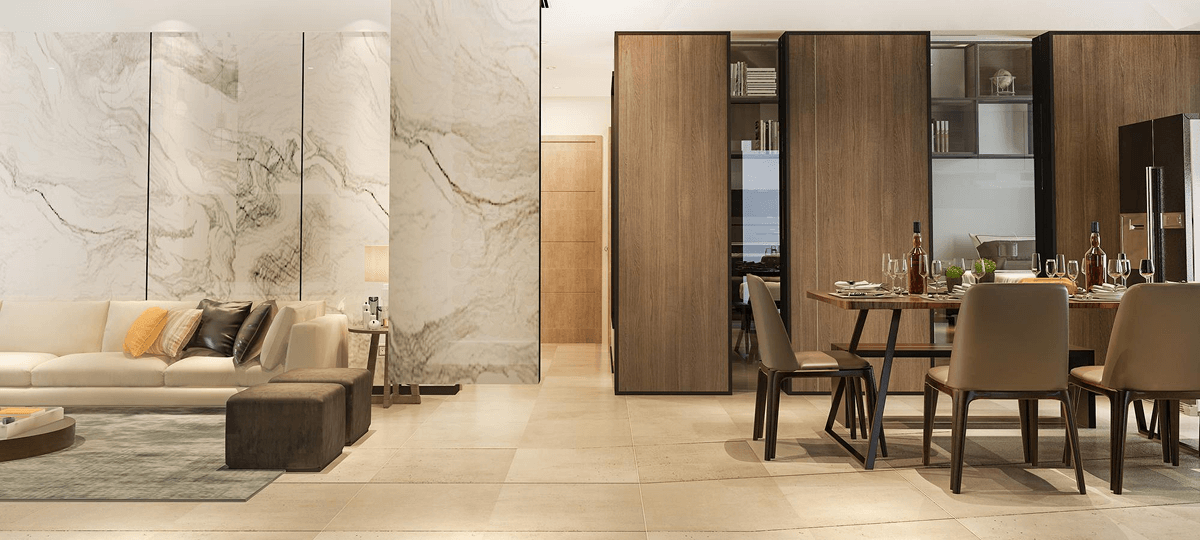
Your dining room is also a part of your living room since there is no partition exists between them in most cases. Considering this fact, you need to choose floor design for your dining area that complements the living room floor design. So, like your living room, choosing large format tiles will be a great option. Large format porcelain creates a calm field with fewer joints, which helps the room feel spacious. Mid tone stone look or terrazzo look hides crumbs between cleanings. Aim for PEI ratings suited to frequent chair movement and check DCOF only if the space connects to a wet balcony. Try a border inset to frame the table or a diagonal layout to widen sightlines. You can also add felt pads to chair legs to prevent scuffing.
6. Hallway and entry
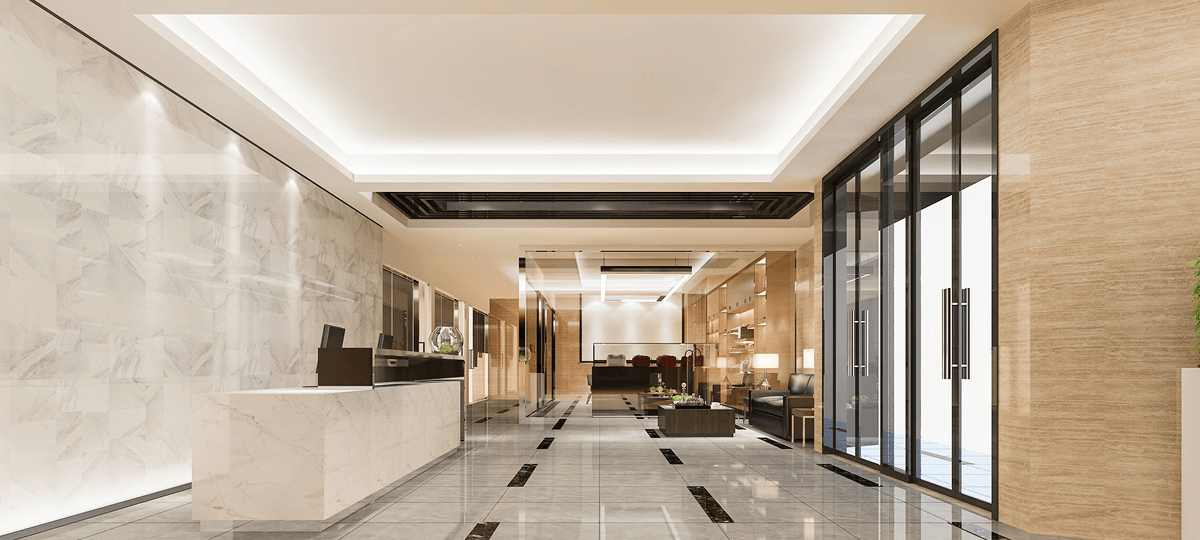
First impressions start at the floor. And it's an open reality that hallways and entries carry heavy foot traffic, dirt from shoes, and sudden weather shifts. That means your tile design needs to be more than pretty. Choose durable porcelain with a slip-resistant finish, especially one rated for wet conditions. Mid-tone colors like taupe, textured greys, or rustic browns do a better job of hiding dust and marks between cleanings. Diagonal or staggered layouts can help narrow spaces feel wider. If your entry gets a lot of light, go for a low-sheen surface to cut glare. And always plan for a strong doormat area at the threshold.
7. Balcony
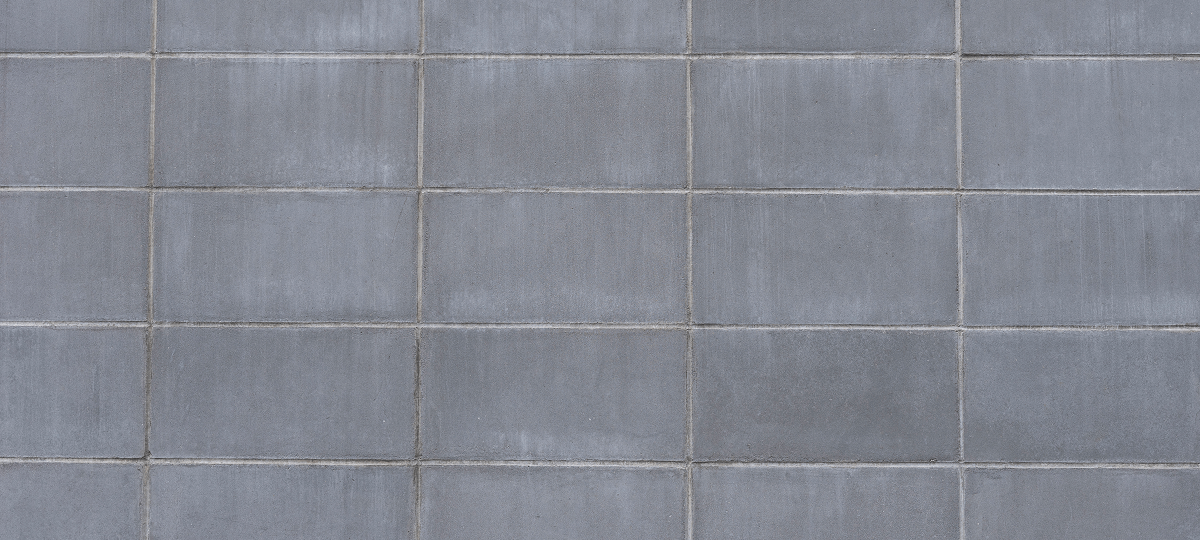
A balcony feels simple until you realize it faces the toughest mix of sun, rain, and dust. That’s why the tiles design for floor here should balance durability with comfort. So, here it’s crucial to pick outdoor-grade porcelain or vitrified tiles with low water absorption and a slip-resistant surface rating. Textured matte finishes work best here. They dry quickly after rain and stay safe under bare feet. Neutral or earthy tones reduce glare in direct sunlight and blend well with plants or outdoor furniture. Choose smaller formats for easier drainage slope, and check grout lines for weatherproof sealing so water doesn’t creep beneath the tiles.
8. Kids room
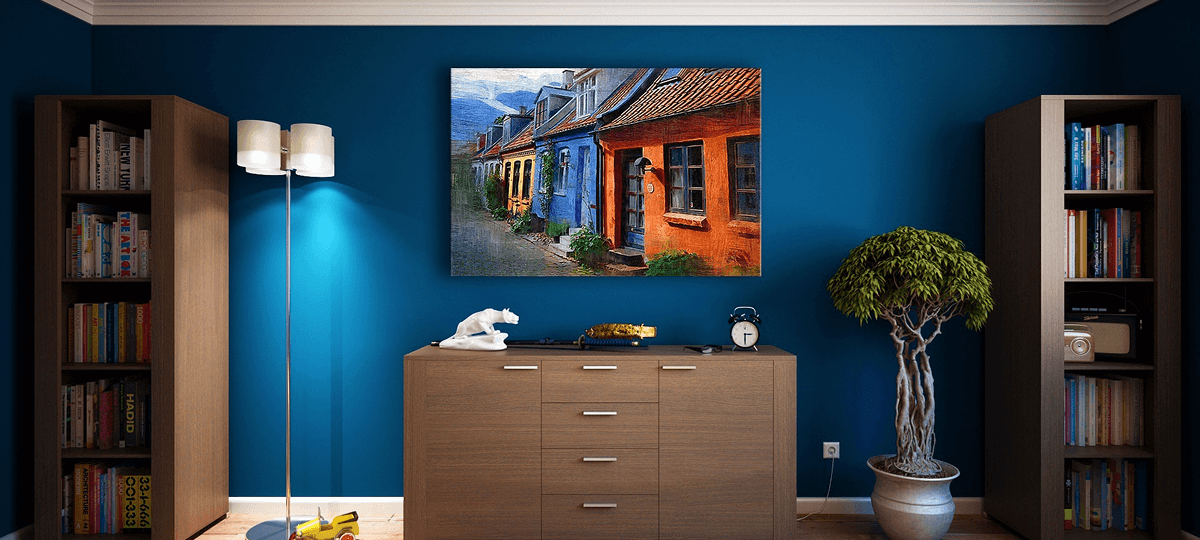
Quick Selector Table for Floor Tiles Design
Different rooms demand different designs, patterns, textures, and sizes for tiles. With this quick table on floor tile design for floor, you can compare floor tile size, layout pattern, finish, slip rating, and grout color at a glance for different floors. You will see fast picks for living room, bedroom, kitchen, bathroom, and balcony so you can balance space, safety, cleaning, and budget before reading the detailed sections that follow.
| Room | Best sizes | Patterns that work | Finish and slip | Grout choice | Notes that save hassle |
|---|---|---|---|---|---|
| Living room | 60×60 for most flats; 80×80 or 60×120 for larger spaces | Straight for calm; diagonal to widen; herringbone with 60×120 planks | Soft matte to cut glare; light texture if kids or guests are frequent | Shade match for a seamless look; stain-resistant grout | Fewer grout lines make the room feel larger. Add a small border only if the walls are square. |
| Bedroom | 60×60 or 20×120 wood-look planks | Straight or brick bond for a quiet feel | Matte or satin for a warm, low-glare surface | Warm grey or tone-on-tone | Soft looks and low contrast read as cozy. Add a rug without high pile for easy cleaning. |
| Kitchen | 60×60 or 30×60 near tight layouts | Straight or brick bond; avoid busy diagonals | Textured matte near sink and cooktop; aim for R10-R11 | Mid-grey or epoxy for stain control | Mid-tone colors hide splashes. Keep joints narrow for hygiene. |
| Bathroom | 30×30 or 30×60; mosaics for slopes | Straight; small-format mosaics in shower | Textured matte with clear slip rating; aim for R11-R12 in wet zones | Epoxy or polymer-modified | Plan the drain slope early. Large format outside the shower, small inside for grip. |
Quick tips based on this selector
- If the room is small, prefer larger formats with tight joints to reduce visual grid.
- Glossy is fine for low-traffic living rooms, but avoid it in kitchens and baths.
- Match grout to tile for a seamless canvas. Use a mid grey where stains are likely.
- For slip safety, check actual product data. R10 is typical for kitchens, R11-R12 for wet zones.
- Want a feature moment without clutter? Use Cross or Hexa only in a defined area, then keep the rest in a simple straight lay.
Floor Tiles Price in Bangladesh
If you are planning a project, a clear price band helps you choose with confidence. In Bangladesh, ceramic floor tiles commonly start in the ৳50 to ৳150 per square foot range for popular sizes such as 16x16 and 24x24, which suits most living and bedroom floors. Porcelain floor tiles usually land around ৳120 to ৳350 per square foot, reflecting higher density, lower water absorption, and more detailed glazing or printing.
For vitrified options including GVT and PGVT, expect roughly ৳180 to ৳400 or more per square foot, especially for large formats like 24x24 and 24x48 that minimize grout lines and create a seamless look. Imported selections often begin near ৳250 per square foot, driven by freight, format, and surface technology.
Do not forget labor and prep. Tile installation in Dhaka frequently starts around ৳36 per square foot for standard floor fitting, with higher rates for re fitting, complex layouts, substrate leveling, and specialty grouts.
Final cost depends on tile body, size and thickness, rectified edges for tighter joints, finish and texture for slip resistance, and the pattern you choose. Add a sensible 10 to 15 percent contingency for cuts and breakage, then sample at home to confirm color under your lighting.
Quick price bands for floor tiles at a glance
| Segment | Material example | Typical sizes | Avg. tile price per sft |
|---|---|---|---|
| Budget local | Ceramic single fired, entry porcelain | 12×12, 16×16, 24×24 | ৳50 to ৳120 |
| Mid range | Porcelain glazed, vitrified GVT or PGVT | 24×24, 12×24 | ৳120 to ৳250 |
| Premium or imported | Vitrified large format, PGVT slabs, rectified edges | 24×48, 32×32, 30×60 and larger | ৳250 to ৳400+ |
How to Choose the Best Floor Tiles for Design
Selecting the right tiles design for floor is not just about appearance. It’s about how the material behaves with your light, traffic, and daily rhythm. Here’s a practical, room-proof guide to making that choice with confidence.
1. Define the room goal
First, think about what each room demands. A living room benefits from a calm, open look and easy cleaning. Kitchens face spills and frequent mopping, so denser porcelain or vitrified tiles make sense. Bathrooms need high-grip finishes to stay safe in wet conditions. Bedrooms call for warmth underfoot and soft light reflection. When you understand a room’s function, design choices get easier and more meaningful.
2. Pick the look family
Every tile design carries a mood. Stone-look tiles feel timeless and elegant, wood-look tiles add warmth and comfort, terrazzo-look tiles bring playful texture, and cement-look tiles offer a minimal modern base. Choose the look that matches your home’s character rather than chasing short-lived trends. The goal is harmony, not showmanship.
3. Match size to space
Tile size quietly shapes how a room feels. Large-format tiles create the illusion of space by reducing grout lines, ideal for living and dining areas. Smaller formats, like 12×12 or 12×24, fit bathrooms and kitchens better where slopes and tight corners need more cuts. Measure twice, plan layout direction, and test a dry lay before fixing to avoid awkward edge pieces.
4. Choose the surface finish
Finish affects both style and safety. Matte or textured tiles provide traction in wet areas and give a grounded feel underfoot. Low-sheen finishes suit bedrooms and family spaces where comfort matters. Glossy tiles reflect more light and enhance brightness in shaded corridors but can be slippery when wet. So, always try to balance beauty with practicality.
5. Check performance specs
Look beyond color and pattern. Porcelain tiles with water absorption below 0.5% stay stronger and less prone to stains. For wear resistance, aim for a PEI rating of 3 to 5 in floor use. And if you live in a humid area or have outdoor transitions, check the DCOF (Dynamic Coefficient of Friction) value, anything near 0.42 or higher provides safe grip in wet conditions.
6. Decide layout and grout
Layout defines the mood. Straight or staggered patterns create calm, while herringbone, chevron, or checkerboard adds character and movement. Rectified tiles allow narrow grout lines for a seamless finish. Lighter grout blends for a unified surface, while darker grout highlights pattern and helps mask daily dust.
7. Test and total the budget
Before ordering, always request samples. Place them on your floor and observe under natural and artificial light. This quick step prevents color surprises after installation. When you estimate cost, include the tile price, adhesive, grout, and labor. After all, a well-planned floor looks intentional and stays easy to live with for years.
Ending Note
Every floor tells a quiet story. The tiles you choose decide how that story feels underfoot - warm, cool, calm, or bold. A thoughtful tiles design for floor goes beyond looks; it shapes how light moves, how sound travels, and how comfortable each room feels in everyday life.
If you have already read this far, now you already know the basics of tile design techniques for different floors. This guide might not be the bible, but you can definitely consider it as your treasure map to keep you on the right track.
Whether you prefer the grounded texture of matte stone, the warmth of wood-look planks, or the elegance of polished finishes, the best design is the one that fits your rhythm. So, take time to explore, compare samples, and see how each surface reacts in your own light.
Frequently Asked Questions
What type of tile is best for flooring?
Porcelain is usually the safest bet for floors because it has low water absorption, high density, and strong wear resistance. Look for PEI 3 to 5 for residential floors and a DCOF value near 0.42 or higher in wet zones. Ceramic can work in dry, low traffic rooms. Vitrified options, including GVT and PGVT, offer extra strength and crisp prints.
Which color tile is best for the floor?
There is no single best color. Mid tone neutrals hide dust and scuffs, which helps in living rooms, halls, and kitchens. Light shades make small rooms feel larger and brighter. Darker tones add drama but show lint and water spots more, so pair them with a sensible cleaning routine and matching grout.
How many cm is a 24×24 tile?
Twenty four inches equals about 60.96 cm × 60.96 cm. Many tiles marketed as 24×24 are actually the metric 600×600 mm format, which is 60×60 cm. Nominal size, rectification, and grout joint can create small differences, so check the product sheet before planning cuts.
How much is 1 square foot of tiles in Bangladesh?
Expect broad ranges by segment. Budget ceramic often sits around ৳50 to ৳120 per square foot. Mid range porcelain is commonly ৳120 to ৳250 per square foot. Premium or imported vitrified formats can run ৳250 to ৳400+ per square foot. Installation, adhesives, and grout are additional, and complex patterns increase labor.
Which floor tile is strongest?
Full body or double loaded porcelain and vitrified tiles are among the strongest for residential use. Aim for very low water absorption near 0.5% or less, a PEI 4 to 5 wear rating, and rectified edges if you want tight joints that distribute load evenly.
What is luxury tile flooring?
Luxury typically means premium vitrified or glazed porcelain with realistic stone or wood visuals, high flatness, and refined finishes. Think large formats such as 600×1200 mm or bigger, polished or soft satin surfaces, rectified edges, and consistent calibration. These tiles create seamless visuals with fewer joints and a high end feel.
Related Blogs
More Insights for You
Sollicitudin adipiscing id non lorem. Sit egestas nisi amet ipsum gravida mauris aliquam. Mattis eget rutrum adipiscing iaculis.

23 Mar, 2025
Wall Decoration Ideas Beyond Wall Tiles: Decor with Creativity

08 Apr, 2025
Creative Home Decor Ideas for Small Spaces and Bengali Homes

22 Apr, 2025
Wall Interior Design Ideas: Modern Looks for a Stylish Home

23 Apr, 2025
Top 12 Duplex House Design In Bangladesh that You’ll Love

13 May, 2025
Drawing Room Decoration in Bangladesh: Your Dream, Our Idea

19 May, 2025
Smart and Affordable Office Interior Design Tips Bangladesh

22 Jun, 2025
Luxury Bedroom Interior Design: Top 8 Trends for 2025

26 Jun, 2025
Must-Have Room Decoration Items From Living Room to Bathroom

30 Jul, 2025
Modern Home Decor Ideas to Make Your Home Stand Out

31 Jul, 2025
How to Choose the Best Dinner Wagon for Your Home

04 Aug, 2025
Stylish & Functional Kitchen Design in Bangladesh

11 Aug, 2025
Home Decoration Items in Bangladesh | Where Style Meets Affordability

27 Aug, 2025
Kitchen Cabinet Design Ideas for Bangladesh

14 Sep, 2025
Tiles Design Ideas for Every Room in Bangladesh

25 Sep, 2025
Tiles Texture Ideas for Every Room in Bangladesh 2025

23 Oct, 2025
Modern Bathroom Tiles in Bangladesh: Styles, Price, and Design Tips

04 Nov, 2025
11 Modern Kitchen Tiles Design Ideas for Bangladeshi Home

20 Nov, 2025